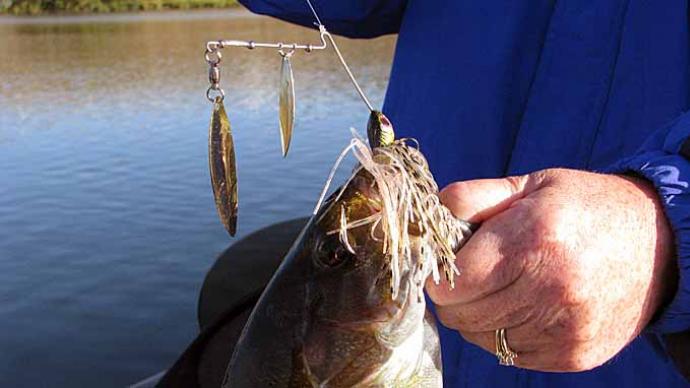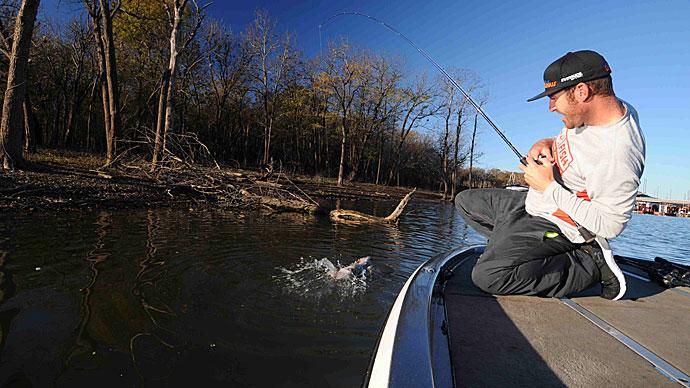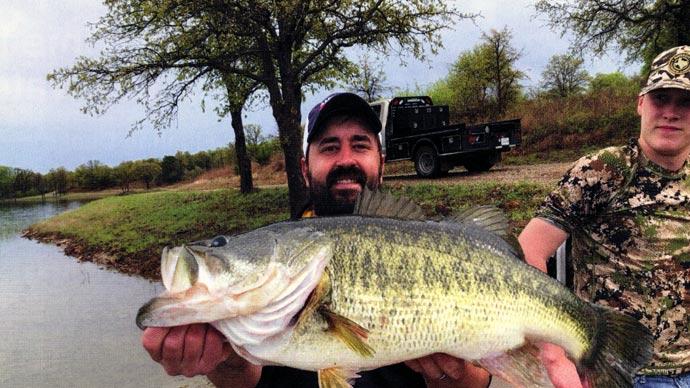| A DIFFERENT SPIN |
WEIGHTIER SPINNERBAITS When Kevin VanDam wants to fish deeper than his heavyweight production spinnerbaits run, he wraps solder around the wire directly in front of the lure's head. Sometimes, he will increase the lure's weight to more than 1 ounce. "The solder stays tight and lets me adjust the weight while fishing," says VanDam. "If I need to lighten the bait, I just unwrap a little bit of the solder and clip it off." CLEANUP BAIT Even when VanDam first fishes an underwater structure with a deep diving crankbait and a Carolina rig, he always cleans up by slow rolling a heavy spinnerbait through the same area. "Most of the time," VanDam says, "that's a summer pattern. I finish with the spinnerbait because it covers a depth zone above the bottom where bass may be suspended. It gives them a different look and often takes them holding on a piece of structure." HEAVY SPINNERBAIT TACKLE Kilby, Ferguson, and VanDam rely on similar tackle when fishing heavy spinnerbaits. All of them opt for 6 1/2- to 7-foot baitcasting rods. A medium-heavy action handles most situations, but a heavy action may be called upon when extra muscle is needed to snap a spinnerbait cleanly through heavy weeds. All three anglers fish monofilament on the heavy side, 17- to 20-pound test, although Ferguson frequently drops to 15-pound test. High-speed reels do most of the work, especially when burning spinnerbaits for smallmouth bass. |
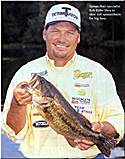
If Academy Awards were presented for best lures, the spinnerbait would be a unanimous winner in the category "most versatile." No other lure more efficiently probes the shallows and deep water pulls bass from such a wide variety of cover, or works so well in water clarity that ranges from crystalline to mocha.
It's no coincidence that practically every bass angler on the planet owns scads of spinnerbaits in every size, color, and blade configuration imaginable. Many anglers, however, fail to take full advantage of this powerhouse lure because they neglect the heavier sizes. A 1/2-ounce spinnerbait falls into the light end of the heavy spinnerbait spectrum. A 3/4-ounce size serves as the workhorse, while some situations call for spinnerbaits weighing as much as 1 1/2 ounces.
One more widely employed heavy spinnerbait strategy is slow-rolling submergent weed beds. This ploy pays off big time during the pre-and post-spawn phases for Rob Kilby of Hot Springs, Ark., a regular on the professional tournament circuits.
"A great example of a place to slow roll for pre-spawn bass is Sam Rayburn," says Kilby. "This pattern holds up from November through March until the bass move shallow to spawn."
At that time of year, the grass typically grows 4 to 7 feet from the bottom in 15 to 20 feet of water. Common structures that support grass include points and high spots. Since the tops of the weeds lie roughly 7 to 15 feet beneath the surface, you must find grass beds with a depth finder. Two critical locations for bass in deep grass are inside and outside weed edges.
"If the bass are turned on and feeding," says Kilby, "they'll be on top of the grass and close to the inside (shallow) grass line. If it's a bluebird day after a cold front, they will be strictly out on the outside edge near deep water."
Whichever edge of the grass bed Kilby targets, he holds his Ranger boat off the vegetation and casts a 3/4-ounce spinnerbait over the cover at a perpendicular angle. His favorite spinnerbait configuration comprises a Nickel No. 3 Colorado lead blade and a gold No. 5 willow leaf. He opts for a shad-colored skirt and dresses the hook with a white 6-inch ribbon-tail worm. After casting, he counts the spinnerbait down to the greenery and slowly retrieves it through the edge of the growth.
"You have to bump the grass with the spinnerbait to get bites," says Kilby. "They often nail it when the lure catches a strand of grass and suddenly breaks free."
The species of grass dictates how Kilby fishes it. When fishing elodea, a tough weed, he simply lets the spinnerbait sink until it lands on the grass. A sharp pull breaks the spinnerbait free, after which he begins the slow roll retrieve. Milfoil, on the other hand, is a soft weed that readily fouls a spinnerbait. When fishing milfoil, Kilby counts the spinnerbait down and begins the retrieve just as the lure reaches the tops of the stalks.
"You'll have to strip milfoil from your spinnerbait on three or four casts until you determine the right count," says Kilby. "Then you should be able to maintain the retrieve at the most productive level. Hydrilla is tougher than milfoil and doesn't foul the spinnerbait as badly."
Kilby targets river channel edges when fishing grass lakes during the post-spawn period. This approach has yielded excellent catches for him on lakes such as Alabama's Guntersville. He takes a lot of bass slow rolling a heavy spinnerbait in the 8- to 12-foot depth range at this time.
"When I fish channel edges," says Kilby, "I cast parallel to the grass lines, which is exactly the opposite of what I do for pre-spawn bass."
Heavy spinnerbaits also produce big bass from shallow grass, as Art Ferguson discovered when he started guiding during the winter months on Lake Okeechobee. This Michigan resident has qualified for 10 Regional tournaments and finished third in a tournament held on Lake St. Clair, where he guides for smallmouth bass in the summer.
"The first 10-pound largemouth I ever caught from Okeechobee came on a big spinnerbait," says Ferguson. "I use a 3/4-ounce bait a lot to get down near the bottom in 5-to 7 feet of water when fishing eelgrass. A lighter bait just won't get down in that stuff."
When fishing eelgrass, Ferguson opts for a spinnerbait that features a gold Oklahoma blade ahead of a smaller nickel willow leaf. "I like that Oklahoma blade in thick grass because it puts out so much vibration," says Ferguson. Though a slow roll retrieve pulls bass from eelgrass for Ferguson, lately, he has been scoring bigger fish with a lift-drop action.
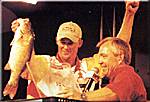
"I work it almost like you would a worm," he says. "I let it sink to the bottom, lift it with the rod tip, and flutter back down. They usually hit it on the fall. When I fished a major buddy tournament on Okeechobee with my friend Jerry Ware, we caught nearly 40 bass using that method. The six we weighed in went 24 pounds."
When fishing tournaments on impoundments laced with deep creek channels, Ferguson grinds a 1-ounce spinnerbait along stump-lined ledges that drop abruptly into deeper water. Sometimes, he bumps the lure into stumps 18 to 20 feet deep.
"That's a good pattern before the bass spawn," says Ferguson, "and also in the summertime on the main lake. You'd better be ready for action when that blade bait careens off a stump. This technique catches big fish."
During summer guiding trips on Lake St. Clair, Ferguson burns a 3/4-ounce spinnerbait just beneath the surface as fast as he can crank a high-speed baitcasting reel. To keep the bait from rolling on its side, he opts for undersized willow leaf blades, a No. 3 1/2 followed by a No. 4. The heavy spinnerbait casts for distance, which puts it in front of smallmouths that haven't been spooked by the boat, especially on calm days. The long casts also comb large grass/sand flats quickly. The upbeat pace excites smallmouths and triggers reflex strikes.
"I've had especially good luck with chartreuse blades and a chartreuse skirt with a few strands of orange mixed in. I usually don't use a trailer. After the spawn, we bring up a lot of bass ripping spinnerbaits over 8 to 11- feet of water. When a 5-pound smallmouth annihilates a big spinnerbait screaming across the surface, it feels like your rod's been hit by a lightning bolt."
Ripping smallmouth bass with heavy spinnerbaits is also a mainstay for bass pro Kevin VanDam, who has extensive experience with smallmouths throughout the Great Lakes. His preferred spinnerbait is a 3/4-ounce matched with white, tandem, No. 4 and 4 1/2 willow leaf blades. The truth is, VanDam is intimately familiar with slow-rolling heavy spinnerbaits for deep largemouths and with any technique that applies to heavy spinnerbaits. It's unlikely that any other professional angler boats more bass with these lures.
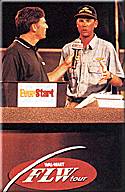
"Waking" a heavy spinnerbait up near the surface, is just one of many ploys VanDam uses to lambaste heavy-weight largemouths. This method puts the spinnerbait up in the same zone as when burning it for smallmouth bass, but the retrieve speed is slower, which holds more appeal for largemouths. VanDam slows the lure's pace by increasing the size of the blades and retrieving with a high rod tip.
"This is a clear-water technique," VanDam says. "The advantage to running a spinnerbait within 6 to 8 inches of the surface is that waves or surface chop breaks up the lure's outline. You don't want the bass to get a good look at the bait. That's one reason this approach works so well on windward banks."
When VanDam fishes a heavy spinnerbait in murky water, he switches from willow leaf to Indiana or Colorado blades for increased vibrations. He also runs his lures closer to cover.
"The difference between clear and dirty water is how far the fish will come to hit the bait," VanDam says. "if you've got 10 feet of water clarity, those fish will come a long way to hit a spinnerbait. That isn't so in dirty water. In that case, I keep the lure running tight to boat docks, bushes, trees, and chunk rock banks."
VanDam fully appreciates the long-cast advantage afforded by heavy spinnerbaits. He covers water so quickly with this lure, especially during tournament practice rounds, that his competitors watch him almost in disbelief. Long casts are essential to VanDam when he is making parallel casts.
"If you're paralleling a bluff bank or something like that," VanDam says, "long casts let you run a spinnerbait over a bass two or three times before your boat gets to them. That gives you more opportunities to tempt a strike."
Content provided by Bass Fishing Magazine, the official publication of FLW Outdoors


